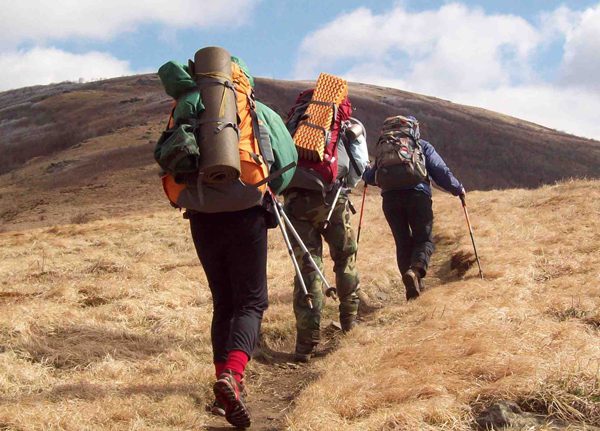Backpacking basics and the 2014 Uwharrie Trail thru hike

Last summer, LandTrust of Central North Carolina staff, interns, and friends participated in the first backpacking thru hike of the full Uwharrie Recreational Trail. Thanks to more than 15 years of conservation work, this trail can now be hiked in its 40-mile entirety. We got such positive response from our first thru hike, that we are doing another one this coming May.
Since advertising this hike, we have had several inquiries about backpacking in general and what’s needed for a trip of this length. In response, I have put some notes together in preparation for the upcoming hike and for general information for new backpackers.
|
Join the second annual “thru hike” Uwharrie Trail thru hike backpacking trip this year will be May 29 through June 1. There is an option to join the hike on Friday, May 30th, with a longer first day. Attendees must bring their own gear and supplies, but The LandTrust will provide transportation and the expert guidance needed to make this adventure possible. Scroll below for contact information. |
It is a common misconception that you need a lot of gear to get started, or that you need to spend a ton of money to have the lightest gear. In my opinion, backpacking only requires a few major items, with some additional items to make your trip more comfortable. I’ve accumulated some nicer gear as I’ve gone along, but I didn’t start out buying the best or lightest of everything.
I would say that if you are going to purchase items, it’s wise to invest in a good backpack that fits you comfortably, and a nice sleeping bag. My 25-degree down bag is my most expensive backpacking item, but I do not like to be cold, and it has kept me warm and dry in some pretty rough conditions.
You also need a tent, but if hiking with friends you can easily get a two or three person that is affordable and split up the various parts (tent, stakes, poles) to distribute the weight amongst you. I have a simple foam egg-crate pad to go under my sleeping bag, which I prefer over the inflatable ones as they may puncture or leak and then you are out of luck.
In addition to those basics, I do have a list of items that I make sure to include:
For water purification I carry a water filter. I also use a hydration bladder and a few Gatorade bottles for water containers (I find them to be lighter than most other water bottles).
Of course you will need food and snacks, along with a food bag or Ziploc to store them. Also, a cup and eating utensil – you can buy lightweight sporks that work well or you can get one from a fast food restaurant. Those little salt and pepper packets restaurants have can also spice up a pasta or rice packet, usually my dinner of choice. Preparing the food requires a stove, fuel, a firestarter, as well as a pot and handle – these are items you can likely share. I use a simple alcohol stove made from a soda can and it works great (Google it and you can find out how to make one yourself).
I always bring a knife, a headlamp and backup flashlight. Rain gear and a pack cover are also necessities, especially in the mountains of North Carolina where any three-day period will probably mean some rain. You can use a trash bag as a pack cover. Rope or paracord (a nylon parachute cord that is very strong and lightweight) comes in handy, and is needed, especially if you are in bear country, for hanging your food or for hanging rain gear out to dry. You’ll want some extra clothes and socks but don’t go overboard – clothes are heavy, so try to take only what you really need. Gloves and a wool toboggan are also on my list, and are nice to have on cold nights. Other necessities include a toothbrush and toothpaste, ibuprofen, paper towels, toilet paper, and a plastic trowel.
A few other items I typically take along include a compass and maps (especially if you are not already familiar with the trail), trekking poles, soap or hand sanitizer, and a bandanna. It is a good idea for someone in the group to have a basic first aid kit, as well as an emergency blanket or two. I like to use those as ground cover under my tent to help keep it dry. Extra Ziploc bags for trash, tissues, a hat, and sunglasses are other items that come in handy and don’t add much weight.
My one major luxury is a small backpacking pillow. Many folks just use a sack stuffed with their extra clothes as a pillow, but I never think that works very well and I like the comfort of an actual small pillow, so to me it’s worth the weight.
This list may not be all-encompassing, but I find that it is generally enough to get me by on backpacking trips. I have not done much winter backpacking, so I am certain there are additional items you should consider if you will be facing winter weather conditions.
There are some portions of Uwharrie Trail still in development, so if you join us on the thru hike, you will get a first hand preview of these newly restored sections. Join us as we journey through some of the oldest mountains in the world, explore the Land Trust’s recent land acquisitions, pay tribute to the trailblazers, and uncover the secrets of the past.
For more information about the thru hike contact Crystal at crystal@landtrustcnc.org .